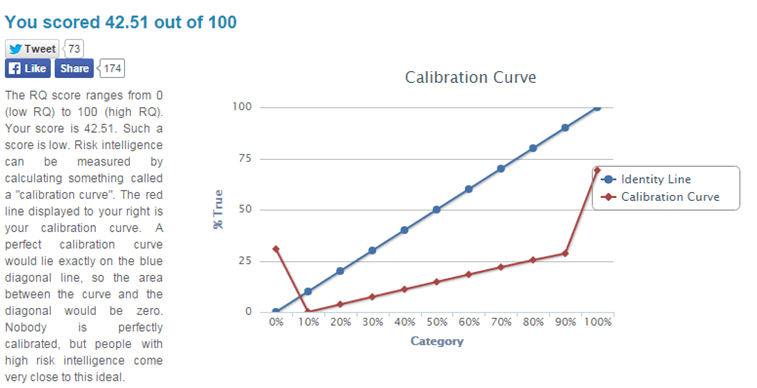How to Test Your Risk Intelligence Quotient
Related articles:
- What is Your Risk iCue?
- Are You Risk Intelligent?
- Risk Intelligence and the Quest to Dumb Down Safety
- Risk Intelligence, Thinking and Decision Making
Thanks to Hayden Collins (author of How is the unconscious in communication critical for understanding and managing risk? ) for sharing this:
From the Projection Point Website: “Risk Intelligence Quotient (RQ) is a measure of a person’s ability to estimate probabilities accurately. People with high risk intelligence tend to make better predictions than those with low RQ”
The site provides a free basic test of your RQ or domain specific expert tests (sports, military, finance and security) for a charge. The basic test consists of 50 statements like: “There are more people in the world than chickens”, for which you must rate each one from 0% to 100% true depending on how confident you are in the answer.
Video by the author of the test:
You can score very highly in this test even if you don’t know that much. This test measures your self-knowledge rather than factual knowledge. You gain better scores for gauging your own level of uncertainty more accurately, rather than for just knowing a bunch of trivia and facts.
This test is not about how much you know. But about being able to gauge how well you know that you know. TAKE THE TEST HERE and let us know how you went (compared to how you thought you would go).
Some thoughts on Risk IQ by Dr Rob Long:
When we think of the concept of intelligence we often think of a person’s IQ. The idea of an Intelligence Quotient is not reliable and only tests certain selected forms of literacy constrained by cultural biases. For example: the early settlers in Australia deemed that the Indigenous people were not intelligent based upon such misconceptions. Some continue to maintain the erroneous belief that a standardized test can measure intelligence. Similarly, some safety people try to maintain the nonsense measurement of safety by the presence of injury and the absence of events. See:
https://safetyrisk.net/measurement-in-safety-youve-got-it-all-wrong/
https://safetyrisk.net/the-seduction-of-measurement-in-risk-and-safety/




Do you have any thoughts? Please share them below